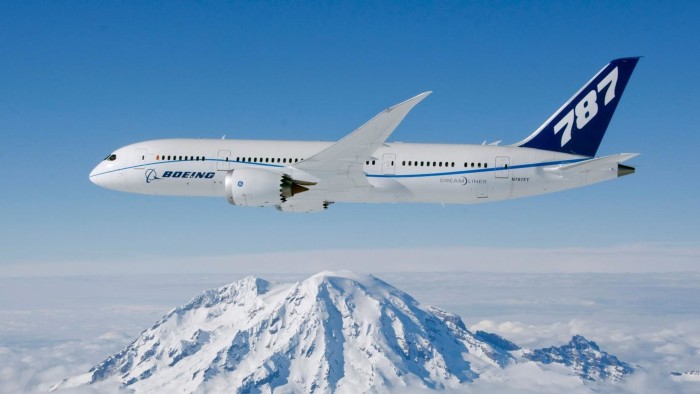Smarter aircraft create a wealth of data but it remains underexploited

Roula Khalaf, Editor of the FT, selects her favourite stories in this weekly newsletter.
Machines are growing ever smarter. And the almost 22,000 civil airliners that carry millions of passengers a year around the globe are no exception.
The newest aircraft to take to the skies, from Boeing’s 787 Dreamliner to Airbus’s A350 wide-body jet, are even more connected than the passengers they carry. According to Airbus, even its A380 superjumbo — which first flew a decade ago — collects information on more than 200,000 aspects of every flight.
This wealth of data is generating a wave of excitement in the aerospace and aviation industries. “There are important opportunities to create value,” says Didier Lux, head of customer services at Airbus, the European aircraft manufacturer.
Aircraft manufacturers talk about the possibilities for predictive maintenance, or fixing the aeroplane before it breaks down. If the crucial parts of an aircraft are equipped with sensors, they will be able to transmit information to engineers on the ground, who will be ready and waiting with parts when it lands.
“These aeroplanes generate a lot of information,” says Randy Tinseth, Boeing’s head of marketing. “We are trying to find out how we use that information . . . how we can make aeroplanes more available, more reliable.”
The potential savings are huge. Maintenance accounts for about 10 per cent of an airline’s operating costs and close to half of its delays. According to the aerospace arm of SAP, the software group, the cost of keeping a commercial passenger jet grounded while being worked on can run to as much as $10,000 an hour. Reducing that downtime through more efficient maintenance schedules could bring big financial gains to carriers.
Rolls-Royce, the world’s second-biggest aero-engine maker, was one of the first in the aerospace industry to innovate using the data streamed by its engines. Instead of making money on the turbine itself, the UK-based group offered airline customers the chance to buy a package based on the number of hours its engines kept an aircraft flying.
Twitter Q&A

• How is the oil price collapse affecting civil aviation manufacturers and paying passengers?
• How safe is air travel? How is the industry taking steps to avoid repeats of the past year’s civil aviation disasters?
• Is private space travel about to enter the mainstream?
• Small companies are becoming the backbone of the space industry. Does space exploration belong in the hands of government?
• Combat drones are coming. How soon will they be waging war?
Join us on June 15, at 15:00 BST using #FTaero to discuss
It used the real-time information about its 12,000 operating engines to monitor their health and reliability, in essence, taking on the risk of power plant-related downtime.
“We combined the latest-generation communications with data analytics to make sure we know what the engines are doing in service and what early intervention might be needed,” says Paul Stein, chief scientific officer of Rolls-Royce. “By being able to make decisions about which engines need to be pulled off, overall fleet reliability has been growing and growing.”
Boeing and Airbus, emerging from a painful period of heavy investment in aircraft programmes that will not return a profit for several years, are lured by the higher margins that can be achieved on such contracts. In recent years they have been moving away from pure manufacturing to become systems integrators and service providers, a trend that will accelerate as the demand for data grows.
“Maintenance is a market that is very fragmented, but there are opportunities and we know we can grow into it,” says Boeing’s Mr Tinseth.
These opportunities go beyond maintenance. With one terabyte of data generated on every flight, aircraft manufacturers are considering how to leverage the information they gather across their global fleets.
Boeing and Airbus are looking at how they might help pilots adjust their navigation through real-time chart planning to avoid turbulence or bad weather, for example. They might also track how fuel consumption differs according to piloting techniques.
Nadun Muthukumarana, an industrial partner at Deloitte’s consulting arm, says: “They are getting richer information that allows them to be more innovative, to create components that last longer, and increase availability in the field.”
But there are limits to this blue skies scenario, not least the ability to filter out the bits that matter from the thousands of terabytes generated every day.
“It is complicated,” says Mr Tinseth. “An engine tends to have one manufacturer and a data-rich environment. With an aeroplane, you have hundreds or thousands of suppliers. There are 21,600 aircraft flying today and each has a wide variety of capability in terms of information. It is an apples and oranges world.”
Another industry executive suggests there is a lot of hype around the potential for mining this mountain of data in radically new ways. “We have always had this data,” he says. “But it is like teenage sex. Everyone is talking about it and saying they’re doing it, but we know it isn’t happening.”
One of the biggest obstacles — in the short term at least — is the lack of sufficient communications infrastructure to harvest and transmit the data, according to Mr Stein of Rolls-Royce. “Current technology restricts us to a few tens of kilobytes of information in flight. That is enough for flight safety,” he says, but it will take more capacity to realise the dreams of those looking to provide services based on a constant stream of real-time information while in the air.
The industry has also long warned of a shortage of engineers as older workers retire. Concerns are now being voiced about whether there will be a new shortage of skilled employees able to transform this information into practical business solutions.
Eventually however these obstacles will have to be overcome. As each generation of aircraft and engine arrives, big efficiency gains are becoming harder to achieve. Further progress may depend on knowing where the richest seams of real-time data lie. “Over time the information will be better understood,” says Mr Tinseth. “But it will take time.”
Comments